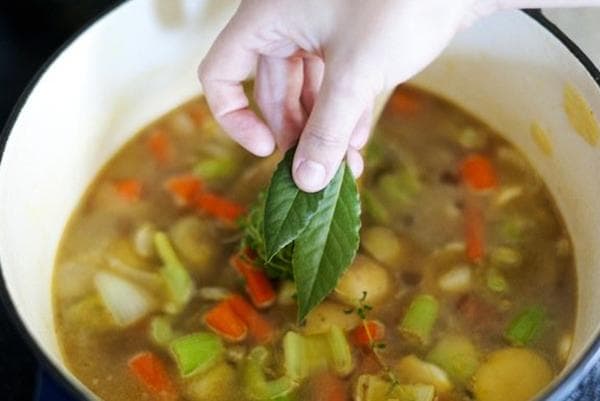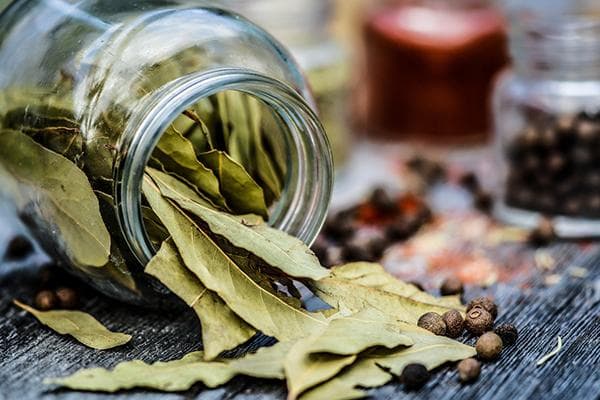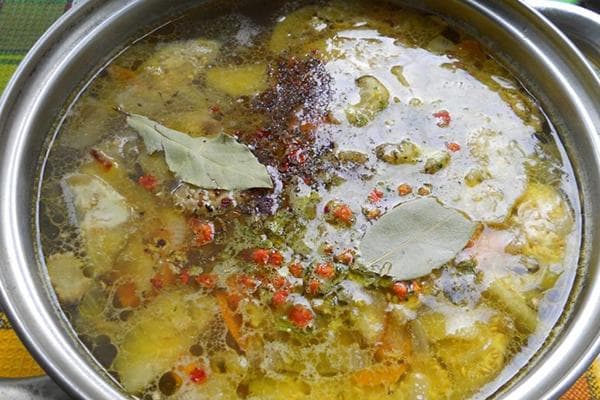Bay leaf in soup: how, when and in which soups to add?
In Russia, it is traditional to add bay leaves to soup. But not everyone knows the secrets of this ancient Mediterranean spice. To fully reveal its aroma, you need to follow a number of rules. We will tell you how, when and in what soups laurel leaves are added.

Bay leaf in soup
The dense light green leaves that we take out of the package are nothing more than the leaves of the evergreen laurel tree. The same one from whose branches wreaths were woven in Ancient Greece. Since ancient times, laurel has symbolized victory, greatness and glory. Its leaves, mostly whole and dry, are used in cooking.
The spice is valued for its aromatic properties and benefits for the body:
- enhances the smell of cooked fish, mushrooms and meat;
- prevents premature spoilage of food;
- prevents intestinal colic and indigestion.
Bay leaves have virtually no effect on the taste of the soup. The sense of smell picks up specific notes in the aroma of food, which is why the taste seems changed: bitter, pleasantly tart. The laurel also smells of vanilla, lemon, and cloves. The aromatic bouquet of the spice is so rich that it is added to a wide variety of dishes: first courses, second courses and even desserts.
For a long time, laurel leaves were used only to flavor water that was used to wash hands before meals. They began adding spice to food only in the 1st century AD. e. At first, fruit desserts were prepared with the leaves - baked apples, figs.But gradually the scope of application of bay leaves expanded. Today, all over the world it is added to soups, marinades, canned food, pickles, stews, meat and fish dishes, and jellies. Crushed leaves are included in recipes for pates, sauces, and sausages. Liqueurs are flavored with the spice, and in the East tea is brewed with it.
When to add?
Like greens, bay leaves are added at the end of cooking. It is added to the soup 5 minutes before it is ready. You can throw in the leaf later, just before turning off the fire. It will infuse in boiling water and release all its aroma and taste. After this, the leaves must be removed so that there is no bitterness. Plus they are too hard. If the spice gets on your teeth, it won't be pleasant.
Leave the bay leaf in the soup for 5–15 minutes. After this time, it is removed and thrown away.
How to add?
In production, bay leaves are not washed before drying. This means that there are particles of dust and dirt on it. Of course, boiling neutralizes microbes. But it is still advisable to rinse the leaves with running water or scald with boiling water before adding them to the soup. After this, they are lightly rubbed against each other. This makes the smell of the spice more pleasant and pronounced.
Bay leaf has a bright aroma. If you overdo it with the amount, the soup will acquire too strong notes and will be bitter. According to the rules, spice is added at the rate of 1 medium leaf per 1 liter of liquid.
What soups should I use it in?
Bay leaf goes well with most first courses. It is added:
- in fish soups;
- in cabbage soup;
- in meat soups, especially with pork;
- in mushroom soups;
- in borscht;
- in dishes with legumes - peas, beans, lentils.
However, some soups do not use it.For example, in milk, fruit, cream, onion, and also chicken.
The subtler the smell of the first dish, the worse the lava leaf will fit into it. Spices should highlight the aroma and taste of the main ingredient, and not interrupt it.
Is it possible to replace it?
The aroma of bay leaves is unique and rich. It is often used in combination with allspice or without any additions at all. It owes its smell and bitterness to essential oil, acetic, valeric and other acids. They give a pleasant spicy aroma and bitterness.
Fresh laurel leaves are much more bitter than dried ones. As it dries, the bitterness dissipates, but the aroma remains.
Calamus is closest in smell to bay leaves. Also, bay leaf is replaced in first courses with rosemary, thyme, oregano, basil or a mixture of herbs. In chicken soup, carrots and celery, onions, and parsley are used for flavoring. Bay leaves and allspice in chicken dishes can only be found in home cooking. Professional chefs do not use them in this case.
Bay leaf is a famous spice that can be found in every Russian home. It's a rare housewife who won't throw it into the soup. However, most people do this without thinking about the combination of flavors and following the rules for adding laurel. It’s correct to throw it in 5 minutes before the first dish is ready. And after another 5–10 minutes, you must definitely take out the leaf. However, it should not be added to chicken soup at all, so as not to destroy the delicate aroma of the broth.




I've never added a bay leaf! The taste of the broth is lost. I don’t add onions either, just a little carrot for beauty. I brew noodles, it boils a little and then I turn it off so that the noodles don’t boil over. My grandchildren love this soup.
Laurel will ruin the taste of any dish. It is impossible to eat dishes with the addition of the miracle leaf; even mayonnaise does not save the situation. It is only suitable for pickling!!!
Or maybe you’ll learn to eat without ointment; laurel doesn’t even spoil the dishes, but rather adds flavor and aroma to them. But all the spices are for everyone, some people don’t add salt to their food and it’s delicious to them, while others throw in different herbs that shock their nose, and it’s also delicious for this person.
I add bay leaf to everything. The taste is more intense.